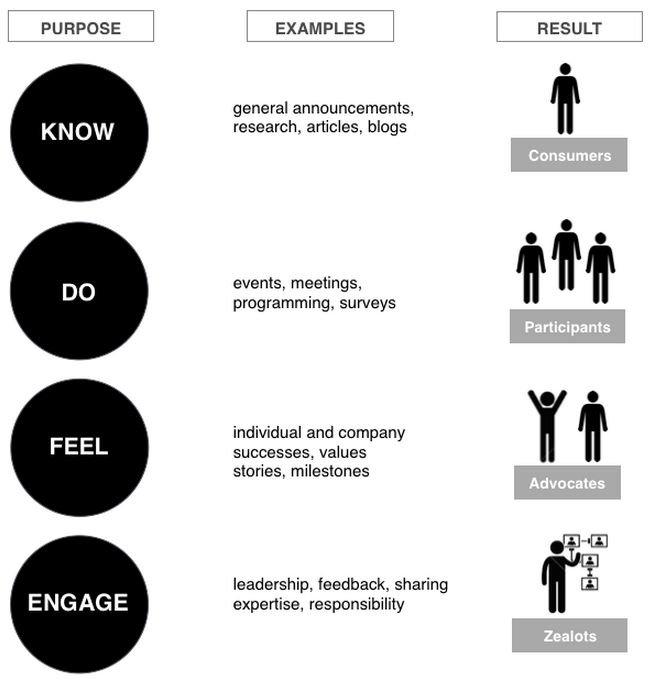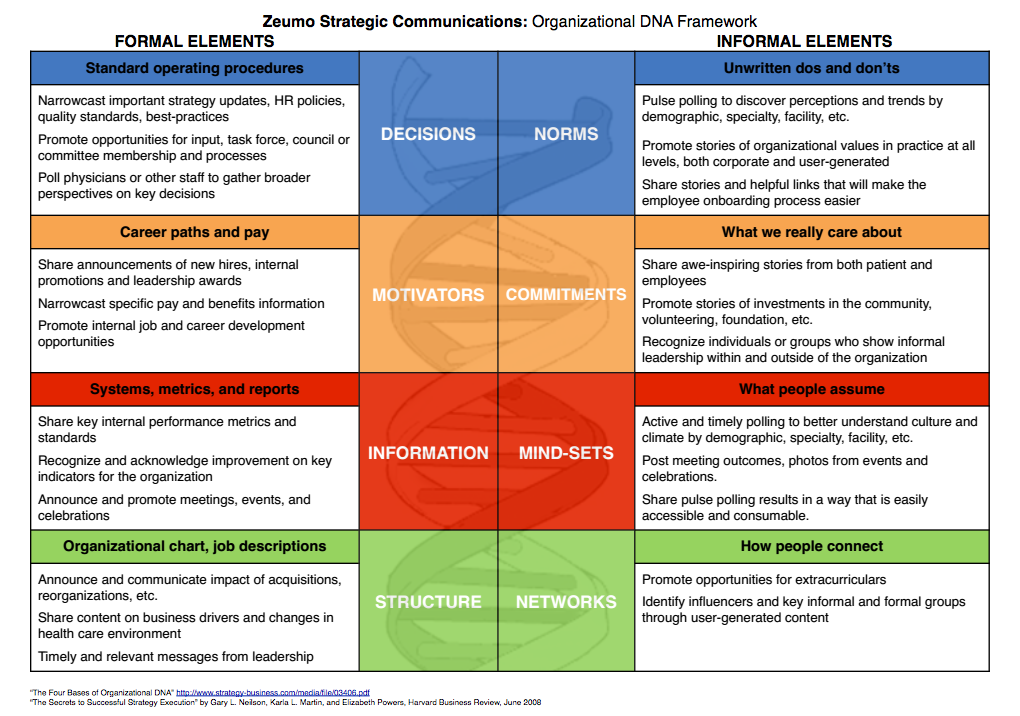|
Writing business communications for a mobile audience is very different than writing for the web, much less a pdf newsletter or “fax blast!” Content can be harder to comprehend and consume. It’s typically viewed on the move, read on a tiny screen, and scrolled with the flick of a thumb.
So, if you want someone to read your message, you better make it a thumb-stopper. Here are a few tips: 1. Match the audience and content. If you can’t do this one right, the rest won’t matter. “All staffs” are rarely for all staff and any message that starts with “if this doesn’t apply to you, please ignore” cues everyone to ignore it. It says that you don’t care enough to select the right audience, so I don’t care enough to read it! 2. Use a strong Subject/Headline: Mobile audiences are used to scrolling for information with the flick of a thumb. Subject/headlines count. A mobile reader will decide with a glance if a message is worth reading. A good subject/headline is no more than six words and lets a reader know exactly what they will find when they click to read the message. Or, better yet, maybe it can convey the whole message. For example: “Parking Lot 4 Closed Today” versus “Pardon the Inconvenience” 3. Use keywords to grab attention. Assuming you have chosen the right audience (see 1.), you should also know what is important to them. So, choose words in your subject/headline that will automatically express relevance and timeliness for the particular recipients. Generic words get generic responses. Focusing on a few keywords can also help prevent long, meandering headlines. 4. Be focused and concise. These two work hand-in-hand. Focus on one topic so you don’t bury the recipient in information and you don’t bury important topics in an epic list. Mobile audiences are not going to cull through complex or layered information and they probably aren’t interested in a display of your literary prowess. 5. Make clear questions or calls-to-action. If you want someone to do something, don’t hide it. Whether it’s just feedback on a question or a direct order, making the prompt clear from the start will give you a better chance of getting the response you want.
0 Comments
If you don’t really know why you are communicating, then your audience won’t really know why they should listen.
An effective communication strategy requires a mix of communication types, not only in terms of media, but also in terms of reasons why you are communicating. We typically overwhelm people with things we want them to know (whether they asked for it or not) and things we want them to do (whether they want to, need to, or not). These are largely transactional communications. And, despite their prevalence, when it comes to building a connection with your audience, “know” and “do” communications are the weakest forms (other than communicating to hear yourself communicate, of course). At some point, we need to make people feel and feel a part of (engage) what we are doing as an organization. After all, transactional communication will deliver transactional relationships. If we want something more, we need to communicate accordingly. Organizational culture and communication are ubiquitous; both inputs and outputs that persist beyond operational or organizational silos. They exist whether they are invested in or not. They actively define the nature of the system whether they are acknowledged or not. They are the DNA.
So, I have taken a stab here at showing how you might apply the Organizational DNA Framework to a more strategic internal communication plan, that Zeumo can help you deliver, of course. Strategic information in organizations can be paired down to two primary types: 1. what I (the employee) want or need to know, and 2. what the organization wants or needs me to know. Sometimes they are the same. Often they are not.
In fact, if they are the same, you probably have a strong culture and decent communication strategy, articulating a clear and engaging message and delivering it effectively. But, for many of us (if we are honest), that sort of alignment is still an aspiration. Often organizations are predominantly either want-to-know organizations or need-to-know organizations. Want-to-knows pride themselves on being highly participatory and democratic. They want their people involved and they believe in the knowledge of their people to drive their work. Anything “top-down” can even be taboo. Need-to-know organizations invest specifically in top-down models of information flow. Given the “right” information, their people will execute and the end result will be effective and efficient performance. The premise, although probably packaged differently, is: “we’ll just tell you what you need to know.” In the extreme (which I have seen both), neither works. Want-to-knows can be so “organic” and participatory that the direction of the organization is perpetually unclear, and roles and responsibilities (even deliverables) become uncertain. Everyone is involved but little gets done. Despite the intention of building a positive and engaging culture, frustration slowly brews as clarity and execution wanes. Alternatively, need-to-knows risk alienating their people and losing the leverage of their “local” knowledge. As people adapt to narrow sources of information from the top, their confidence in themselves and those closest to them breaks down. Deference to others for decision-making sets in. The organization becomes inefficient and slow to respond to its environment. People stay really busy but don’t seem to get much done. So, if you build a communication strategy, whether for an entire organization, a division, or a department, you have to be courageous enough to let your people speak and smart enough to listen for understanding. You also have to be bold enough to have a clear voice and articulate a compelling direction for your people to rally behind. Your organizational information flow is constant; whether or not it is strategic or qualifies as communication is up to you. When we look around at the broad array of new technologies for our organizations, we often start by saying: “I need it to do _____.” And, if it does _____ then we sign up for it.
Maybe, it goes something like this: “Oh no! My doctors are texting each other and it’s not HIPAA compliant! We need HIPAA compliant texting!” And, somewhere down the line, after responding case-by-case, need-by-need, we finally take note of the plethora of silo’d platforms and systems we are still investing in and the graveyard of those dead and gone. We wonder what happened! Each had some promise. Each did something we said we needed done! But, hopefully, doing things isn’t what our organizations are about. We are more than an accumulation of activities and tactics. Hopefully, we are about getting stuff done. And, to get stuff done, we need strategy. But, the organizational communication market is stuck between the current limitations of email (and faxes apparently if you are a hospital) and two types of new technology that take their queues from consumer technology more than organizational need: First: Enterprise Social Networks (“We are like Facebook or Linked In for your company!”) There are a couple of key problems with the social network model for strategic organizational communications, however. Because the design is modeled on social networks, these platforms quickly get overrun by those who are “social” and drive out those who hoped the tool would simply make it easier to stay informed. As a result, and because of the openness of the platforms, these networks either generate more communication noise in the workplace or are completely ignored by employees who never wanted another social network in their lives in the first place. Second: Instant Messaging and/or Secure Texting (“The efficiency of texting but most of the messages are from coworkers!”) These platforms are all about now. How do I get this to you now and know you received it? Clearly, there is value here. But, in our organizations, everything isn’t “now” and if it is treated as such, then nothing ends up “now.” When we talk about building culture, about operations, about company strategy, it’s critical but we don’t need a text message. When we want feedback from a group, who really wants to be bombarded by group text messages? When we have policies to read and sign, we don’t need instant messaging. People like social media; that doesn’t mean the model is right for our organizational needs. People like instant messaging and texting; that doesn’t mean it can deliver effective communications across groups and across our company. So, the question isn’t merely, what does it do? The question should really be: can I build a strategy on it?  Most of us don’t think about communication all that much (I admit I am a bit weird). Whether at lunch, in the parking lot, or in the office, it just kind of happens. It’s always happening. It’s often uninteresting. And, we take for granted that, at a basic level, it works. It’s the autonomic system of our organizations. And, like the heart or lungs, when communication breaks down, it can disrupt the system as a whole – often critically. It may not happen the first instance, but it will happen in time. (And, it’s likely to be bad when it does.) Communication’s ubiquity and interrelatedness make investing in and defining a clear communication strategy both imperative and difficult for our organizations. We too often start with the wrong questions (if we actually think about it at all): Who “owns” it? What department does it live in? Whose budget? Do I have to change? Do we need a task force? Some new guidelines? A new technology? Organizational communications isn’t managed in a department or facilitated by one leader, or team, or task force. Effective communication is a value that must be modeled from the top down and owned across divisions, departments, and facilities. It is an operational imperative that requires strategies, tactics, and tools that align with the way we do business and who we do business with. It is a business investment critical to our bottom line and other desired outcomes. It is a commitment and a discipline. To build an effective communication strategy, we need to start with some diagnostics and chart a pathway to wellness. So, let’s start with a few questions: WHY: Why is good communication important to us and our organization? How would it impact our work environment? Our outcomes? The bottom line? WHAT: What would really good communication look like? What do our people want to know? What do we want them to know? What and how much can they consume within their regular workflow? What tools do they currently use? WHERE: Where does critical information currently live? How is it disseminated? Where does critical information die? WHO: Who is “responsible” for communication? Who are the hubs, both formal and informal? Who is key to an effective communication strategy? Whose job and workflow does a new strategy impact? Who supports fidelity to and adaptation of the strategy? “The single biggest problem in communication is the illusion it has taken place.” – George Bernard Shaw
I cannot confirm exactly when he said this (I didn’t look all that hard), but Shaw died in 1950, so, it’s been awhile. What would he think now? Could he possibly have imagined that something so fundamentally true pre-1950 could become exponentially more true by 2014? So, let’s look at the state of the illusion specifically in organizations: We are creating too much noise and delivering too little signal. Sending it in an email does not make it communication. Your message has to be valued, read, and understood by the recipient to become communication. Many of us are overwhelmed by bloated inboxes full of irrelevant emails and don’t feel like sorting through it all to find out what is actually important to us. Most of us don’t have time anyway. “More than half of the email we receive is not a priority to us.” “We are twice as likely to read unimportant email than important.” “We tend to reply to the unimportant emails first.”[i] We are wasting time, energy, and money on poor communication. For many, checking email no longer facilitates our work; it is our work. The ease and expediency of sending an email creates an illusion of easy and expedient communication, but the reality is quite messy. It’s ironic that as initiators of communication we rely on email, and as receivers many of us hate it. Regardless, alternately using and hating it is consuming our workday. “On average employees spend more than half their workdays receiving and managing information rather than using it to do their jobs; half of surveyed workers also confess they are reaching a breaking point after which they would not be able to accommodate the deluge of data.”[ii] Poor communication leads to distrust, dissatisfaction, and disengagement. For most organizations, this reality is clear, but effective communication has remained illusory. And, the impact on our employees and partners has been acknowledged across industries. Research on physicians, for example, shows that they are generally distrustful of hospital management, feel uninvolved in decision-making, and are disillusioned with the level of communication they receive. And, the best-practices and strategic recommendations from across the industry start with developing clear and efficient communication channels.[iii] In sum, communication is critical, but most of us work in a land of illusion. So, what can we do to improve? Be intentional: We have to start taking communication seriously and strategically rather than treating it as something that just happens. We should think about the communications element of everything we do and treat it as fundamental to our internal and external operations. Use the right tools: We need to create and invest in new tools specifically for communication, specifically for our organization. We’ve overwhelmed email. Intranets are stagnant repositories. Social media and social media-ish collaboration tools are noisy and are inundated with messages by a few overactive users – losing their communication value. We can do better if we just concentrate on communication. Focus on implementation, change: We have communicated so poorly for so long, it has become accepted. So, improving communication is also about changing expectations, processes, information flow, and accountability. It requires focus and effective change management. It requires communication. [i] http://www.messagemind.com/pdf/MM-WhitePaper.pdf [ii] http://www.salon.com/2013/10/16/your_brain_needs_more_downtime_than_it_thinks_partner/ [iii] http://www.rqhealth.ca/inside/publications/physician/pdf_files/roadmap.pdf  If we want to create learning organizations, increase engagement, and build strong cultures in our schools, communities, and workplaces, we have to start with effective communication and build from there. Communication is about the exchange of ideas and information. It requires not only distribution but also the effective consumption and understanding by a receiver. It is the (at least two-way) connection of people and content (including nonverbal content). Learning is about bridging what I know with new concepts and experiences beyond my current understanding and purview. It moves the basic connection of people and content toward personal understanding and ownership of concepts. It is the interaction of information, ability, and a sense of possibility. Engagement is a qualifier of the space in-between: the space between people, the space between people and concepts, the space between people and institutions. It is the application and re-formation of learning to one’s context that becomes regenerative. It is where learning forms identity. So, when we talk about communication, learning, and engagement, we must consider and understand: 1. The perceptual space between people:
2. The space between people and the concepts of:
3. The space between people and institutions:
Communication, learning, and engagement live interdependently. And yet, we too often invest in them as independent variables. We invest in communications technologies or processes without ever evaluating our learning environment or the state of engagement in which that communication effort will live (or die). We emphasize and address learning by bringing in consultants and content experts without understanding where our communication failures or basic lack of engagement created learning challenges for us in the first place. Most of us have struggled with the disengagement of others in some form and concocted engagement strategies to address it without ever considering a possible fundamental communication breakdown, or assessing if our assumptions about previous collective learning are actually valid. As we work to strengthen our schools, our institutions, and our workplaces, we need to accept that it is complicated. Single-variable agendas or interventions will deliver single-variable results (if we are lucky). But, starting with effective communication can set the stage for learning, engagement, and success no matter how complicated the task. What was the last good conversation you had? Think about that for a second…
What made this conversation “good” for you? As I consider this question, I can think of a number of conversations in just the past week that I would consider good (By the way, I feel fortunate but have also made many personal and professional decisions that allow me to have good conversations on a regular basis). These conversations range from friendly banter over a beer with a co-worker to a phone call with a high school friend while sitting in traffic to deep strategic planning for the launch of a statewide college access network. They can be about nothing, or they can seemingly be about everything. They include short (less than five minutes) conversations and they include conversations that can go into the hours or even span days. So, what is it that makes these conversations good? For me, as I distill these and other widely varied good conversations I have had, the following criteria seem to arise consistently:
Relationships, safety, learning, teaching, sharing, motivation: all of these outcomes can be found in and developed through a good conversation and, most importantly, regardless of the content of that conversation. Back in 1964, Marshall McLuhan coined the phrase: “The medium is the message.” In other words, because the means through which content is delivered determines how it will be received, the mode of delivery is in itself content, or is at least symbiotic with the content and not discernable. For this reason, content (think everything we test students on) cannot be conceived of outside of its mode of delivery. So, what if we taught conversation? Every day. What if we invested explicitly in the medium through which our youth can communicate effectively their own ideas, develop their own positive relationships, create safety, express their challenges, their explorations, their questions? What if we truly valued and assessed conversation knowing it may be the most vital and valuable life skill we can teach? What if we practiced having and modeling our own good conversations every day? Could we increase safety? Improve relationships and motivation? Open a more equitable process of teaching and learning? I wonder what schools would be like if we included conversation in our core curriculum? |
Categories
All
Archives
April 2024
|


 RSS Feed
RSS Feed